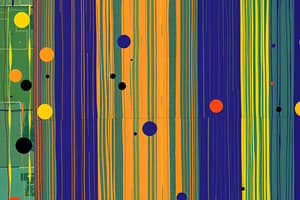Podcast
Questions and Answers
What distinguishes unstructured data from structured data?
What distinguishes unstructured data from structured data?
- Unstructured data is always stored in structured databases.
- Unstructured data follows a specific model.
- Unstructured data is easier to analyze than structured data.
- Unstructured data cannot be contained in a row-column database. (correct)
Which of the following statements is true about data lakes?
Which of the following statements is true about data lakes?
- Data lakes are more costly to update than data warehouses.
- Data lakes are a type of database focusing on specific data.
- Data lakes mainly store structured data.
- Data lakes are used to store raw and all data structures. (correct)
What is a common challenge associated with unstructured data?
What is a common challenge associated with unstructured data?
- It is less valuable than structured data.
- It can easily be stored in data warehouses.
- It is challenging to search, manage, and analyze. (correct)
- It can only be found in structured formats.
In what way is a data warehouse different from a data lake?
In what way is a data warehouse different from a data lake?
Which of the following is an example of unstructured data?
Which of the following is an example of unstructured data?
What is the first step in the data workflow within an organization?
What is the first step in the data workflow within an organization?
What type of data is typically involved in the data collection step?
What type of data is typically involved in the data collection step?
During which step of the data workflow is data cleaned?
During which step of the data workflow is data cleaned?
What is the primary purpose of building dashboards in the Exploration & Visualization phase?
What is the primary purpose of building dashboards in the Exploration & Visualization phase?
What is done with data in the Data Preparation step?
What is done with data in the Data Preparation step?
What can be achieved by exploring and visualizing data?
What can be achieved by exploring and visualizing data?
What is the result of the data being stored in raw format during the first step?
What is the result of the data being stored in raw format during the first step?
What does the term 'Big Data' refer to?
What does the term 'Big Data' refer to?
What is the primary goal of supervised learning?
What is the primary goal of supervised learning?
In the training set D, what does the variable $y_i$ represent?
In the training set D, what does the variable $y_i$ represent?
What type of problem does regression address in supervised learning?
What type of problem does regression address in supervised learning?
In the context of supervised learning, what is a training example?
In the context of supervised learning, what is a training example?
How does the function $h$ relate to supervised learning?
How does the function $h$ relate to supervised learning?
What does the variable $x_i$ represent in the training set?
What does the variable $x_i$ represent in the training set?
Which of the following best describes a training set in supervised learning?
Which of the following best describes a training set in supervised learning?
When predicting house prices using supervised learning, what constitutes the input variable?
When predicting house prices using supervised learning, what constitutes the input variable?
What is the primary role of a Data Engineer?
What is the primary role of a Data Engineer?
Which of the following best describes Big Data?
Which of the following best describes Big Data?
What is a necessary first step in managing Big Data?
What is a necessary first step in managing Big Data?
What are Data Pipelines used for?
What are Data Pipelines used for?
Which of the following is NOT a task of a Data Engineer?
Which of the following is NOT a task of a Data Engineer?
What are the five V's commonly used to characterize Big Data?
What are the five V's commonly used to characterize Big Data?
Why is data corrupted?
Why is data corrupted?
What is the outcome of building prediction models using Machine Learning?
What is the outcome of building prediction models using Machine Learning?
What does a Q-Q plot represent when evaluating normality?
What does a Q-Q plot represent when evaluating normality?
What issue arises from assuming non-collinearity in a regression model?
What issue arises from assuming non-collinearity in a regression model?
Which method can be used to assess multicollinearity in a regression analysis?
Which method can be used to assess multicollinearity in a regression analysis?
Which factor can indicate multicollinearity and lead to issues in regression analysis?
Which factor can indicate multicollinearity and lead to issues in regression analysis?
What is one method to resolve multicollinearity in a dataset?
What is one method to resolve multicollinearity in a dataset?
What is the ideal outcome regarding the plot of normally distributed variables on a Q-Q plot?
What is the ideal outcome regarding the plot of normally distributed variables on a Q-Q plot?
What does the Variance Inflation Factor (VIF) assess in a regression model?
What does the Variance Inflation Factor (VIF) assess in a regression model?
Which graphical representation is useful for evaluating multicollinearity?
Which graphical representation is useful for evaluating multicollinearity?
Study Notes
Supervised Learning
- Supervised learning uses labeled data to train a model to predict outputs for new, unlabeled data.
- Examples include predicting house prices using data about living areas and prices.
- The aim is to learn a function that maps input features to output values.
Big Data
- Big data is characterized by large volume, making traditional data handling methods inefficient.
- One zettabyte is equal to 1021 bytes.
Data Workflow
- Data workflow consists of four general steps:
- Data Collection & Storage: Collection of data from various sources, like traffic, surveys, or media traces. Data is stored in raw format in data lakes or databases.
- Data Preparation: cleaning data, removing missing or duplicate values, and converting it into a more organized format.
- Exploration & Visualization: Visualizing data using dashboards to track changes, compare different datasets, and analyze trends and relationships.
- Experimentation & Prediction: Gaining insights from data to draw conclusions and make decisions. This step can involve building predictive models using machine learning techniques.
Data Engineers
- Data engineers manage the data workflow.
- Their tasks include delivering correct data in the right form, to the right people, and efficiently.
- They ingest data from different resources, optimize databases for analysis, remove corrupted data, and develop, test, and maintain data architectures.
Big Data Management
- Managing big data involves ingesting data from multiple sources, processing it, and storing it.
- Data pipelines enable the efficient flow of data from sources to data warehouses.
Data Types - Unstructured Data
- Unstructured data doesn't follow a predefined format. Examples include Facebook feeds, presentations, and PDF documents.
- It's challenging to search, manage, and analyze.
- It's often stored in data lakes, but can appear in data warehouses or databases.
- Unstructured data is extremely valuable and can be analyzed using AI and ML techniques.
Data Lakes & Data Warehouses
- Data lakes store all raw data, while data warehouses store specific data for specific use.
- Data lakes store all data structures, while data warehouses mainly store structured data.
- A data warehouse is a type of database.
- Data lakes are cost-effective, while data warehouses are more costly to update.
Linear Models - Normality
- Normality is evaluated using Q-Q plots.
- Q-Q plots compare quantiles of the variable to expected quantiles of the normal distribution.
- For normally distributed variables, the relationship should fall on a 45-degree line.
Linear Models - Collinearity
- Multicollinearity occurs when independent variables are highly correlated with each other.
- This can undermine the statistical significance of independent variables and make it challenging to assess their individual effects.
- Multicollinearity can be assessed using correlation matrices and variance inflation factors (VIF).
- It can be resolved by removing redundant variables, using Principal Component Analysis, or other methods.
Evaluating Multicollinearity: Heat Maps of Correlation Matrix
- Heat maps of correlation matrices can be used to visualize multicollinearity.
Studying That Suits You
Use AI to generate personalized quizzes and flashcards to suit your learning preferences.
Related Documents
Description
This quiz explores key concepts in supervised learning and big data workflows. You'll learn about the process of training models with labeled data, and the challenges associated with large volumes of data. Test your understanding of data collection, preparation, exploration, and prediction techniques.




